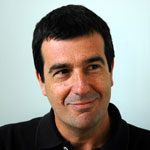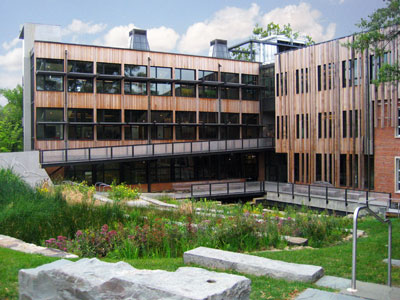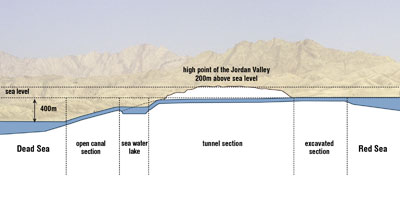News
Interview with Jose Alminana, ASLA, LEED AP, Principal, Andropogon
 Image credit: Andropogon
Image credit: Andropogon
Your work takes a non-invasive, minimal approach to the landscape. How do you balance the desire to design or structure a site with preserving a site’s existing ecology?
For Andropogon, the design comes from the basic elements of the site, but these elements are not static, stylistic features, they are the structuring features of the site that reveal on-going natural (and cultural) processes. We do not see designing with site processes as a restriction. Instead, close observation of nature (and culture) and of natural and cultural patterns and processes gives the landscape architect an almost infinite vocabulary. Our work is fundamentally a place-based design that strives to reveal the “inherent” ecological aesthetic of each place.
Your project for the Nikko Kirifuri Spa and Hotel is in a beautiful part of Japan. How does the site reflect traditional Japanese views of landscape?
 Image credit: Andropogon
Image credit: Andropogon
For Nikko, the site design was generated from the actual, physical landscape of this mountainous region of central Japan, with its highly erodable volcanic soils and native forest vegetation that has many parallels to our own mid-Atlantic, Eastern Deciduous Forest.
The concept for the character of the hotel and spa is based on the idea of a local village in the forest. Our approach in Japan was to go back to the basics of Japanese art. Although we used a number of cultural features including a vine rope bridge, we did not imitate an individual Japanese historical garden style. Instead we went back to the basis of Japanese art—direct observation of nature.
Teaming with Japanese ecologists we added to the cultural framework a second dimension—modern scientific understanding of natural processes and local plant communities and habitats. This is a forested landscape and the plants were generally very familiar to us, with many identical plant genera. We identified all the plant communities and habitats on the site. By rescuing and storing all trees and shrubs within the construction zone we were able to replant with these plants when the construction of buildings and roads was complete. Additional appropriate species were found in local plant nurseries.
Describe your approach to designing the educational wetland courtyard for the Sidwell Friends School in D.C., a LEED Platinum building, which was also listed AIA COTE top ten site. The wetlands at the school are meant to serve ecological and educational purposes. How did you design the site with educational purposes in mind?
 Image credit:: Andropogon
Image credit:: Andropogon
The new addition to the existing Middle School building was built over the footprint of two tennis courts and a parking area. The configuration of the new building created a new south facing courtyard. Through discussions with the school and the project team, it was decided that the courtyard should embody the synergistic interactions between plants, soil biota, and water, which, working together, clean water.
Andropogon’s design included several integrated strategies:
- The landscape of this courtyard manages all the waste water generated by the building, as well as all the rain water that falls on the site. The treated wastewater is used for toilet flushing and makeup water for the cooling tower, reducing municipal water use and the school’s carbon footprint.
- Rain water is managed by a system of permanent ponds that overflow into a rain garden during large rain storms mimicking the functions of a floodplain.
- The constructed wetland terraces echo rice paddies and follow the slope of the hillside. Wastewater and rainwater flows take advantage of gravity. A stepped walkway provides a path through this garden and becomes a small amphitheater for outdoor classes.
- Over 80 plant species native to the site’s ecoregion are used in the display of different plant communities that are associated with diverse soil moisture conditions.
The result is a design where process and place are one. The courtyard is part of the everyday journey to and from the building. The performance of the site landscape is a part of the curriculum and “a new member of the faculty.”
What do you think of the term ‘ecosystem services’? Do you think we will get to a point where all environmental processes will be quantified, and monetized? Does this need to happen to ensure these environmental benefits are properly understood and valued?
Ecosystem services are those benefits and resources provided by nature—at no apparent cost. These services sustain all forms of life on this planet. The current global economy does not recognize the value of these ecosystem services and therefore these costs are not included in the narrow spreadsheet that guides most financial transactions. As the world moves from an oil economy to a carbon economy and carbon becomes a new commodity, any environmental processes that reduce or sequester carbon will be valued and will have a place in the spreadsheet. Pollination, flood mitigation, clean water and nutrient recycling, just to name a few, are ecosystem services whose value needs to be quantified. To help understand these values, there is an immense body of work that has begun to measure these services. This work includes research at the Gund Institute for Ecological Economics at the University of Vermont.
However, let’s not forget that a significant value of environmental processes to human beings is to enrich the human experience by fostering biophillic connections. Ecosystem services are another way of revealing the true value of nature to human beings. Quantification of “services” does NOT replace the value of the aesthetics of a landscape.
You were involved in a planning project for the Jordan River Valley a few years ago related to upgrading the Port of Aqaba, and designing a canal from the Port to the Dead Sea. What did you learn from the experience about water politics in the Middle East?
 Image credit: Andropogon
Image credit: Andropogon
Yes, Andropogon was involved in a plan for the Port of Aqaba (The Jordan Valley Joint Venture in 1999). This project was one of the original proposals to create a Red Sea/Dead Sea link that would bring water from the Red Sea to fill the rapidly diminishing Dead Sea.
More recently Andropogon presented the idea of a Red/Dead sea canal as a framework for a studio design project at the University of Pennsylvania, Department of Landscape Architecture to develop the Jordan Valley.
Strife in the Middle East has been driven by the lack of potable water. Water that fills the Dead Sea originates in Lake Qaraaoun in Lebanon. From there it flows into the Sea of Galilee, and from there into the Jordan River. The Dead Sea derives most of its water from the Jordan River. Over the past 50 years, the Jordan River has virtually disappeared as a result of massive upstream water projects in Israel, Syria, Lebanon and Jordan. Almost all of the water that once replenished the Dead Sea has been taken by upstream industries, agriculture and expanding cities. Each of these countries is vying for very limited water resources and trying to take it at the sources.
Jordan has the least amount of potable water of any country in the world. Its population is rapidly increasing due to a massive influx of refugees from Palestine and Iraq. In the Palestinian territories, Israel uses around 83 percent of the water originating in this region, with only a very small portion going to the Palestinians.
Bringing water from the either the Mediterranean or from the Red Sea is the only feasible way to provide water to Jordan and replenish the Dead Sea. In terms of ecological disasters, a waterless Dead Sea has the potential to turn into the equivalent of the now dried up Aral Sea. It could create massive salt storms that would devastate the entire region. A water pipeline from the Mediterranean Sea is not feasible for Jordan as it would be controlled by Israel and could potentially pollute a huge underground fresh water aquifer.
The proposed Red/Dead canal would carry water from the Red Sea to the Dead Sea. Salt water from the Red Sea could be transported initially in a pipeline over the adjacent topographic rise. At this point sea water could be carried in an open canal to the Dead Sea. Reaching the Dead Sea water would drop 1,500 ft drop in elevation. This drop could provide many synergistic values, generating hydro-electricity for use in powering homes and industries, or to desalinate sea water. New supplies of fresh water would open up new land in a previously uninhabitable area—the lower Jordan Valley. The World Bank is currently doing a feasibility study on this idea.
Sustainable Sites mentioned that if all lawns in the U.S. were added together, they would equal the territory of Mississippi. Maintaining these involves huge amounts of water and chemical fertilizer. What needs to change about how the developed world thinks of man-made landscapes? Will people’s behavior change without policy / regulatory change?
There needs to be a fundamental paradigm shift that recognizes the total dependence of human beings on natural systems. Man-made landscapes must become “productive” as opposed to “consumptive.” It has taken decades for this country to comply with the Clean Water Act and we have seen that a policy/regulatory strategy alone is not an effective option. Our best hope is to educate ourselves and younger generations. Hopefully, a change in attitude (seeing ourselves as a part of nature) will result in much needed behavioral change.
Freeman Dyson, a professor at Princeton and a well-known climate change skeptic, recently said in an article in the New York Times Magazine that he wasn’t worried about climate change. Dyson says it can be solved through ‘human ingenuity,’ new technologies, and planting about one trillion new trees worldwide. What do you say to this? Do you think new clean energy technologies hold the greatest promise? Should international efforts be focused on re-forestation on a massive scale to combat climate change?
Excess CO2 in the atmosphere is almost certainly the result of several hundred years of release of carbon by industrial processes. It will take time to return to pre-industrial levels. While human ingenuity may ultimately solve these problems, and it is always a good idea to plant trees, solutions based on human ingenuity are far too slow to stop the on-rushing crisis.
Several scientists are suggesting we have already reached a “tipping point.” We cannot stop three feet of sea level rise in this next 50 years nor stop the loss of the polar ice caps and other synergistic effects now in play. These changes will likely cause massive socio-political disruption. We should certainly prevent deforestation and plant as many trees as we can, but mitigating the effects of climate change will require a conscientious effort to think, as my partner Carol Franklin says, eco-logically and NOT ego-logically. Again, hopefully, these changes in attitudes will result in a smarter use of the planet’s resources and ultimately provide regenerative systems as the equity for future generations.
Jose Alminana, ASLA, LEED AP, is principal at Andropogon. Alminana is also a visiting lecturer at the University of Pennsylvania, and Philadelphia University.
Interview conducted by Jared Green.